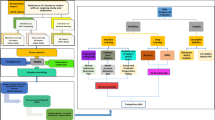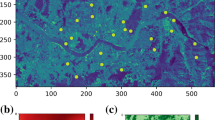Abstract
Air temperature is one of the most important parameters for assessing and monitoring the changing weather and climate patterns. Measurement of air temperature is done from a limited number of automatic weather stations distributed in certain parts of the country, with a lot of discontinuities in space and time because of various operational constraints. Contrary to it, satellites provide seamless observations of Land Surface Temperature in space and time globally, only obscured by the cloud cover. Though Land Surface Temperature and Air Temperature have different physical interpretations, nevertheless some previous studies have shown some correlation between them, which varies according to elevation, land cover type, time of observation (day or night). Hence, land surface temperature can be one of the means to derive air temperature in the regions where the availability of automatic weather stations is limited. The present study attempts to develop a deep neural network-based model to estimate air temperature from land surface temperature based on elevation and land cover. The model results were evaluated by comparing them with ground observations using statistical indices viz., Nash and Sutcliffe’s coefficient of efficiency, Legates and McCabe coefficient of efficiency, Coefficient of determination, and Index of agreement. The values obtained for these indices are 0.74, 0.85, 0.85, and 0.97 respectively, which reflect the predictive capability of the model.



Similar content being viewed by others
References
Azevedo, J. A., Chapman, L., & Muller, C. L. (2016). Quantifying the daytime and night-time urban heat island in Birmingham, UK: A comparison of satellite derived land surface temperature and high resolution air temperature observations. Remote Sensing, 8, 153.
Bhardwaj, A., Jain, K., & Chatterjee, R. S. (2019). Generation of high-quality digital elevation models by assimilation of remote sensing-based DEMs. Journal of Applied Remote Sensing, 13(04), 1.
Caesar, J., Alexander, L., & Vose, R. (2006). Large-scale changes in observed daily maximum and minimum temperatures: Creation and analysis of a new gridded data set. Journal of Geophysical Research. https://doi.org/10.1029/2005JD006280
Chen, F., Liu, Y., Liu, Q., & Qin, F. (2014). A statistical method based on remote sensing for the estimation of air temperature in China. International Journal of Climatology. https://doi.org/10.1002/joc.4113
De Ridder, K., Bertrand, C., Casanova, G., & Lefebvre, W. (2012). Exploring a new method for the retrieval of urban thermophysical properties using thermal infrared remote sensing and deterministic modeling. Journal of Geophysical Research, 117, D17108. https://doi.org/10.1029/2011JD017194
Dousset, B., Gourmelon, F., Laaidi, K., Zeghnoun, K., Giraudet, E., Bretin, P., Mauri, E., & Vandentorren, S. (2011). Satellite monitoring of summer heatwaves in the Paris metropolitan area. International Journal of Climatology, 31, 313–323. https://doi.org/10.1002/joc.2222
GCOS (2016), Implementation plan 2016. (Available at http://www.wmo.int/pages/prog/gcos/).
Hansen, J., Ruedy, R., Sato, M., & Lo, K. (2010). Global surface temperature change. Reviews of Geophysics, 48, 4004. https://doi.org/10.1029/2010RG000345
Hu, L., & Brunsell, N. (2013). The impact of temporal aggregation of land surface temperature data for surface urban heat island (SUHI) monitoring. Remote Sensing Environment, 134, 162–174.
Janatian, N., Sadeghi, M., Sanaeinejad, S. H., Bakhshian, E., Farid, A., Hasheminia, S. M., & Ghazanfari, S. (2016). A statistical framework for estimating air temperature using MODIS land surface temperature data. International Journal of Climatology. https://doi.org/10.1002/joc.4766
Karnieli, A., Agam, N., Pinker, R. T., Anderson, M., Imhoff, M. L., Gutman, G. G., Panov, N., & Goldberg, A. (2010). Use of NDVI and land surface temperature for drought assessment: Merits and limitations. Journal of Climate, 23, 618–633. https://doi.org/10.1175/2009JCLI2900.1
Kilibarda, M., Hengl, T., Heuvelink, G. B. M., Gräler, B., Pebesma, E., Perčec Tadić, M., & Bajat, B. (2014). Spatio-temporal interpolation of daily temperatures for global land areas at 1km resolution. Journal of Geophysical Research Atmosphere, 119, 2294–2313. https://doi.org/10.1002/2013JD020803
Legates, D. R., & McCabe, G. J. (1999). A refined index of model performance: A rejoinder. Water Resources Research, 35(1), 233–241.
Legates, D. R., & McCabe, G. J. (2012). A refined index of model performance: A rejoinder. International Journal of Climatology, 33(4), 1053–1056. https://doi.org/10.1002/joc.3487
Mühlbauer, S., Costa, A. C., & Caetano, M. (2016). A spatiotemporal analysis of droughts and the influence of North Atlantic Oscillation in the Iberian Peninsula based on MODIS imagery. Theoretical and Applied Climatology, 124(3), 703–721. https://doi.org/10.1007/s00704-015-1451-9
Mutiibwa, D., Albright, P. T., & Strachan, S. (2015). Land surface temperature and surface air temperature in complex terrain. IEEE Journal of Selected Topics in Applied Earth Observations and Remote Sensing. https://doi.org/10.1109/JSTARS.2015.2468594
Oyler, J. W., Ballantyne, A., Jencso, K., Sweet, M., & Running, S. W. (2015). Creating a topoclimatic daily air temperature dataset for the conterminous United States using homogenized station data and remotely sensed land skin temperature. International Journal of Climatology, 35, 2258–2279. https://doi.org/10.1002/joc.4127
Parmentier, B., McGill, B. J., Wilson, A. M., Regetz, J., Jetz, W., Guralnick, R., Tuanmu, M. N., & Schildhauer, M. (2015). Using multi-timescale methods and satellite-derived land surface temperature for the interpolation of daily maximum air temperature in Oregon. International Journal of Climatology, 35, 3862–3878. https://doi.org/10.1002/joc.4251
Singh, R., Singh, C., Ojha, S. P., Kumar, A. S., Kishtawal, C. M., & Kumar, A. S. K. (2016). Land surface temperature from INSAT-3D imager data: Retrieval and assimilation in NWP model. Journal of Geophysics Research: Atmosphere, 121, 6909–6926. https://doi.org/10.1002/2016JD024752
Willmott, C. J., & Matsuura, K. (2005). Advantages of the mean absolute error (MAE) over the root mean square error (RMSE) in assessing average model performance. Climate Research, 30(1), 79–82.
Willmott, C. J., Robeson, S. M., & Matsuura, K. (2012). A refined index of model performance. International Journal of Climatology, 32(13), 2088–2094. https://doi.org/10.1002/JOC.2419
Zhang, W., Huang, Z. Y., Yu, Y., & Sun, W. (2011). Empirical models for estimating daily maximum, minimum and mean air temperatures with MODIS land surface temperatures. International Journal of Remote Sensing, 32(24), 9415–9440. https://doi.org/10.1080/01431161.2011.560622
Acknowledgements
We gratefully acknowledge Director, IIRS for his guidance and support. We also acknowledge USDMA for sharing the data.
Author information
Authors and Affiliations
Corresponding author
Ethics declarations
Conflict of interest
The authors declare that they have no conflict of interest.
Additional information
Publisher's Note
Springer Nature remains neutral with regard to jurisdictional claims in published maps and institutional affiliations.
About this article
Cite this article
Bhandari, R., Maithani, S. & Karnatak, H. A Deep Neural Network-Based Approach for Studying the Relationship Between Land Surface Temperature and Surface Air Temperature. J Indian Soc Remote Sens 50, 563–568 (2022). https://doi.org/10.1007/s12524-021-01483-7
Received:
Accepted:
Published:
Issue Date:
DOI: https://doi.org/10.1007/s12524-021-01483-7




